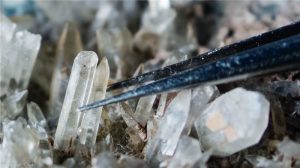
It is becoming more and more appreciated that a major part of the biologic activity is not going on at the ground surface, but is hidden underneath the soil down to depths of several kilometres in an environment coined the “deep biosphere.” Studies of life-forms in this energy-poor system have implications for the origin of life on our planet and for how life may have evolved on other planets, where hostile conditions may have inhibited colonization of the surface environment. The knowledge about ancient life in this environment deep under our feet is extremely scarce.
In numerous cracks down to depths of 1700 meter that have been partly sealed by crystals grown in them, an international team of researchers led by Dr. Henrik Drake from Linnaeus University, Sweden, has traced fundamental ancient microbial processes, including production and consumption of the greenhouse gas methane. The multi-disciplinary approach included micro-scale measurement of stable isotopes coupled with geochronology within minerals formed in response to microbial activity at several Swedish granitic rock sites. This is the most extensive study on ancient microbial activity in the continental crust yet and the findings suggest that microbial methane formation and consumption are widespread in the bedrock.
Henrik Drake explains how they tapped the stable isotope archive of minerals to decipher ancient microbial processes: “It is well known from other environments that methane formation and consumption result in diagnostic isotope ratios in carbonate minerals formed in association with microbial processes. The micro-analyses within calcite crystals showed an extreme range in carbon-isotope compositions, which can only be explained by microbial methane formation and consumption.”
This new knowledge of a deep source and sink for methane of widespread nature in space and time calls for a re-evaluation of the carbon cycling within the vast continental crust and may be significant in a long-term global warming perspective. Christine Heim of University of Göttingen, Germany, a co-author of the study, says: “It is intriguing that we could find biomarkers of ancient organic remains of surficial origin (e.g. land plants) preserved within calcite at great depth and that the nutrient source for the microbes at least partly seems to have been coming from the surface. This connection to the surface biosphere may explain why the marks of microbial activity abruptly disappear at around 700 to 800 m depth.”
Direct timing constraint of the microbial processes reveals for the first time when the biologic activities occurred — at ca 400, 350 and 170 Million years ago. This was facilitated by newly developed dating techniques of high spatial resolution, which is needed for delicately zoned crystals investigated in the study. Life in the subsurface environment of the continental crust has evidently thrived over geological eons, and provides clues about how life sustains in energy poor systems, which is relevant when searching for life in subsurface environments of other planets. Henrik Drake summarizes: “Our multi-phased methodology is clearly well suited for application to extra-terrestrial environments.”
Co-author Thomas Zack from the University of Gothenburg adds: “Cracks in the Earth and on other planets are omnipresent, and our findings indicate that they may be the perfect graveyards for past biologic activities. Who would have thought that? ”
Reference:
Henrik Drake, Christine Heim, Nick M.W. Roberts, Thomas Zack, Mikael Tillberg, Curt Broman, Magnus Ivarsson, Martin J. Whitehouse, Mats E. Åström. Isotopic evidence for microbial production and consumption of methane in the upper continental crust throughout the Phanerozoic eon. Earth and Planetary Science Letters, 2017; DOI: 10.1016/j.epsl.2017.04.034
Note: The above post is reprinted from materials provided by Linnaeus University.










